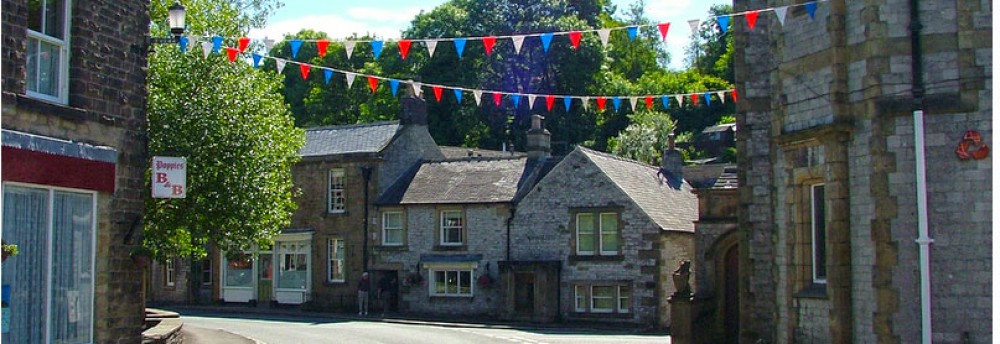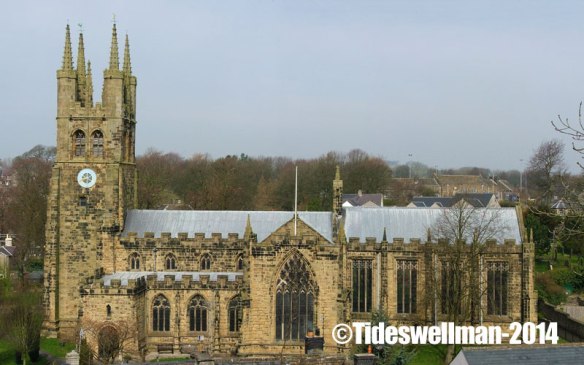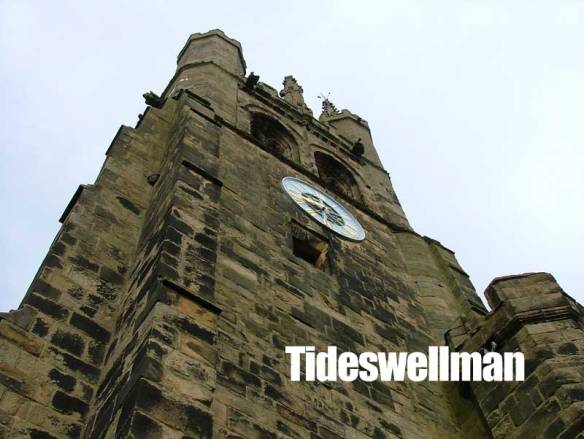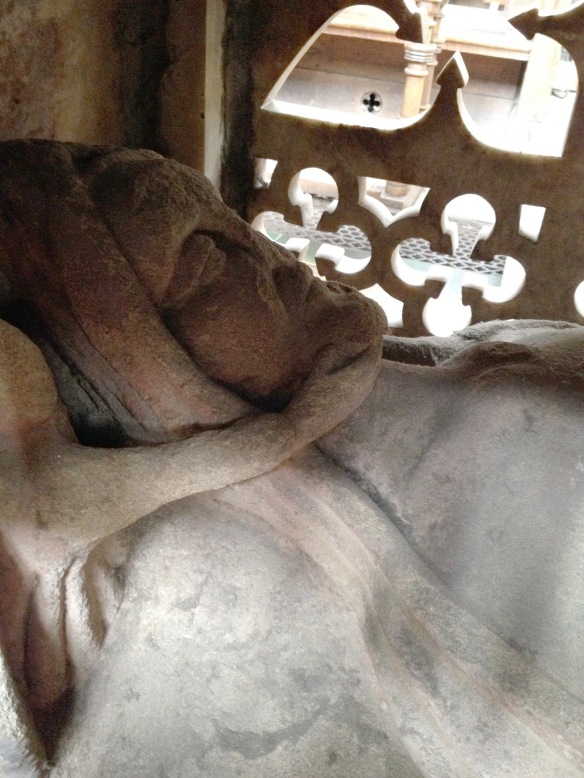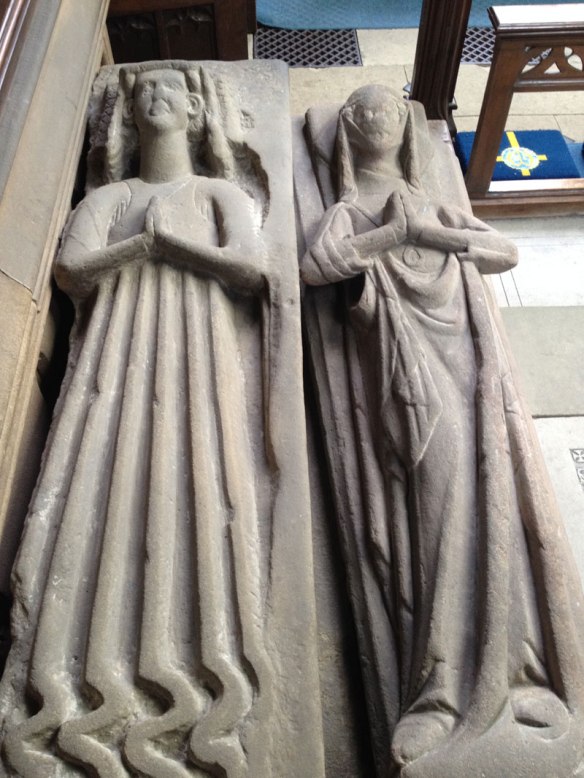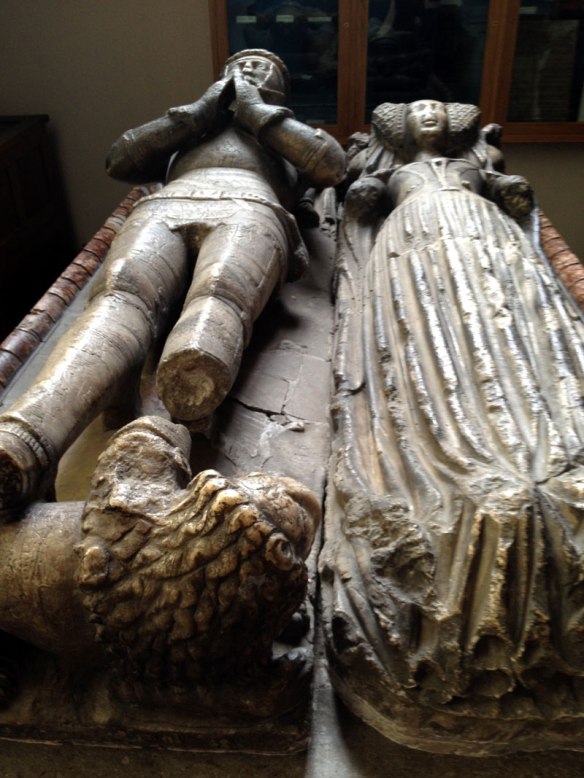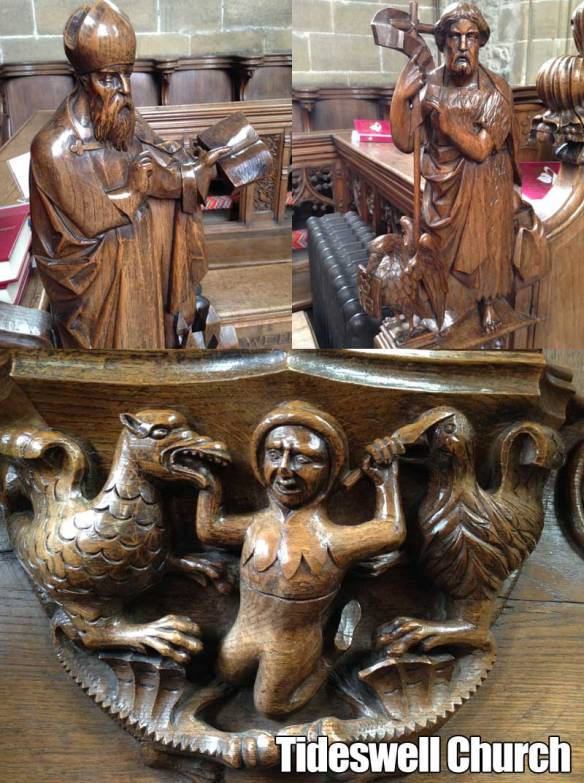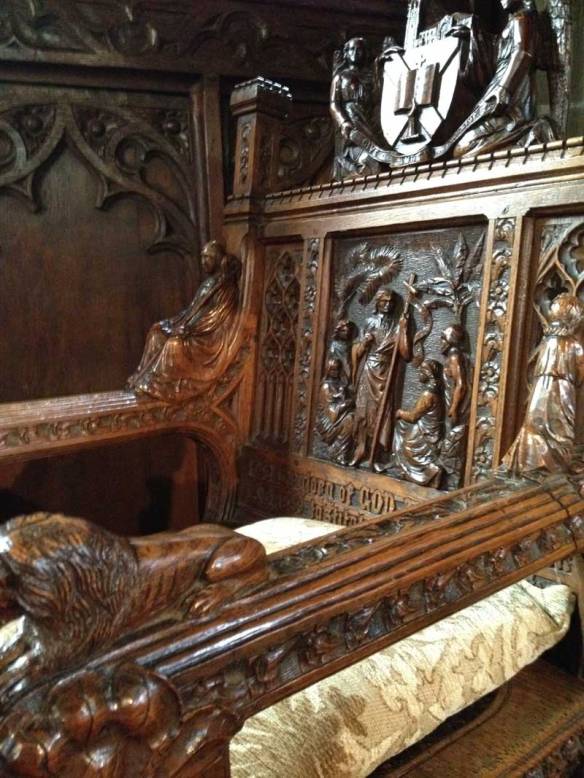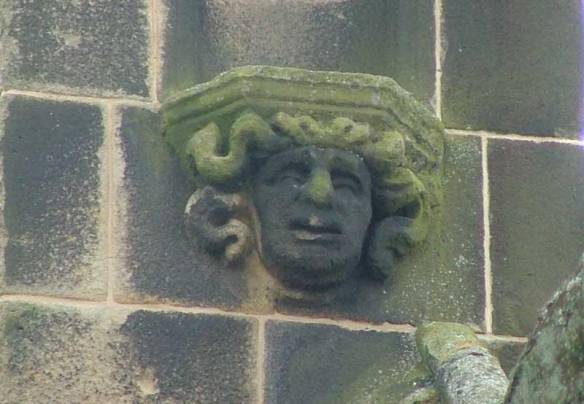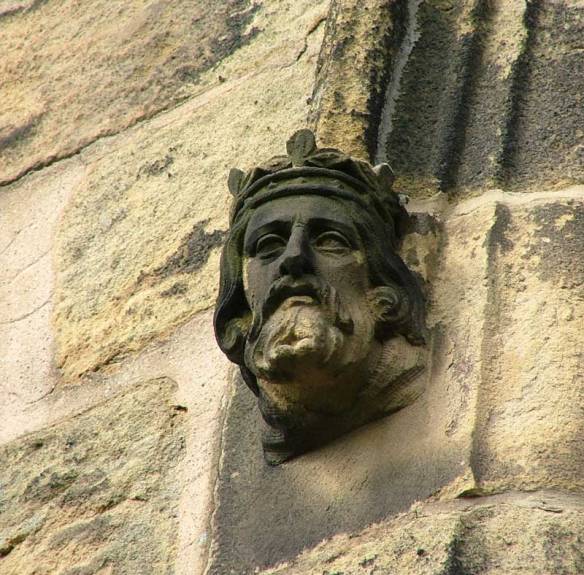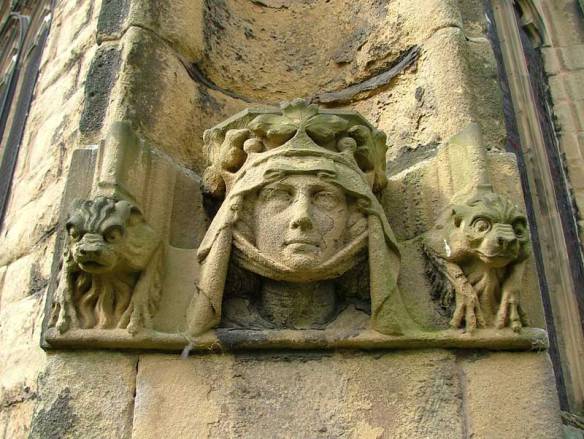Tideswell church, St John the Baptist. Tideswell is a very large ‘Church of England’ Parish Church. It is one of the most important churches in Derbyshire.
I lived in Tideswell until the age of 20. During that time, like most other Tideswellians whether young or old, I consider that I have a special relationship with Tideswell Church. I spent many hours bored rigid in there as a schoolboy, listening to religious services at Easter, Wakes, Harvest and Christmas. I had fun practising for School plays and concerts, I was scared by the creepy tombs, and marvelled at the stone cat and the monkey. I’ve been drunk in the Churchyard, in my teens, hanging out with friends in the churchyard till the early hours. I saw the Duke of Edinburgh there in the 80s, when he looked at our Cub Scout’s Welldressing. I have shared in sombre moments, attending funerals some of good friends and fellow Tideswellians. So it feels right, that I should pay some small tribute to a building that I love.
About Tideswell Church
Tideswell church is famous locally, that is to say, within the Peak District, and perhaps Derbyshire, maybe also amongst those, who like me, appreciate churches and other ancient buildings. There is no doubt that it will have a memorable effect on anyone who has visited it.
The reason that the church is so well known, is because of it’s size and striking architecture. Dubbed the “Cathedral of the Peak” (it is not a cathedral). It is one certainly amongst the most famous churches in Derbyshire, and is a Grade 1 listed building.
Tideswell Church has Norman Influences
The church, replaced a small Norman church, was constructed between approximately 1320 and 1400. The building work was delayed by the Black Death, which also hit nearby Eyam (Plague village). I always like to remind people that the plague wasn’t just in Eyam, but it seems that only Eyam is famous for it.
There are two main styles to the building: the nave ( main body of the church), aisles Corridors) and transepts (wings) are in late Gothic style,(French style Architecture, characteristics include the pointed arch, the ribbed vault and the flying buttress.) and both the chancel (space around the altar) and tower are in perpendicular style.(Focusing on straight lines)
The perpendicular style became popular the Black Death which killed about half of England’s population in 18 months between June 1348 and December 1349 returning in 1361–62 to kill another fifth. This had a dramatic effect on the arts and culture, which it seems became very practical. The nation was affected by the labour shortages caused by the plague so architects designed less elaborately to compensate.
The church underwent was major restoration in 1873 by J D Sedding, which was truly a restoration rather than a reconstruction. In ‘Churches and Chapels in The County of Derby‘, Rawlins described St John’s as being:
“without exception, the most perfect and beautiful specimen of pointed architecture to be found in the County, – or perhaps in any other parish church of its size in the entire Kingdom“
Catholicism in Tideswell
We often forget, that although today, most of our Parish Churches are ‘Church of England’. Many began life as Catholic Churches, Tideswell is no different. Bishop Pursglove, and Nicholas Garlic are Tideswells’ most celebrated and most notorious Catholic Clergy. Unlike local churches such as Hartington and Eyam, There are no signs of the fresco’s that would have covered the inside of the building in Catholic times.
Lichfield vs Lenton – The fight for Tideswell Church.
In 1250–51, the church became embroiled in a dispute between Lichfield Cathedral and Lenton Priory.
Tideswell was one of a several of parishes that had been given to Lenton Priory by the Peverel family during the 11th century. Later, their lands in the Peak District were seized by the crown and granted by King Henry II to his son William The Younger.
After taking the throne, Henry’s son, King John, granted the lands to the Bishop of Lichfield and in turn, they passed to the Dean and Chapter of Lichfield Cathedral.
This transfer began around 300 years of disagreement between the Priory and Cathedral about who was the rightful owner of the Tideswell Church. The legal battle continued throughout this period, including suits in the Vatican Court on several occasions.
Tideswell Church became directly involved in the dispute when in 1250–51, The monks of Lenton Priory armed themselves and attempted to steal wool and lambs from Tideswell,
The Dean of Lichfield Cathedral knew that Lenton would try such a manoeuvre, and ordered the wool and sheep to be kept within the nave of Tideswell church. Strangely, the monks of Lenton did not honour the church’s sanctuary rights, breaking into the building. A violent battle followed, and 18 lambs were killed within the church: either trampled under the horses’ hooves or butchered by the attackers. The Lenton, monks managed to carry off 14 of the lambs. (House of Cluniac Monks, Page, W 1910)
Despite a commission being assembled by Pope Innocent IV, which fined the monks of Lenton Priory severely for their actions. The disputes continued until King Henry VIII ordered the Dissolution of the Monasteries and Catholic power was smashed throughout the land.
Notable Features in Tideswell Church
There are of course several notable features in, on and around the church. Some of the most notable items are the tombs in the Church. There are brasses to Sir John Foljamb, d. 1383 and to Bishop Robert Purseglove as well as several stone table tombs. These tombs used to fascinate and scare me as a kid, the thought of what might lie beneath them petrified me.
The Tomb of Sampson Meveril
In the middle of the chancel, there is an Altar tomb. Within lies Sir Sampson Meverill (1388–1462), allegedly one of the victors of Agincourt. Apparently, Sir Sampson was ‘a bit of a rum lad’. Not averse, in his day, to abducting Jurors, sent to try him. As a boy, this tomb always scared me because, beneath the marble slab, a stone cadaver lies. The stone corpse looks emaciated and creepy. Sampson’s head is held by an Angel, but the ravages of time make the Angel look more like some kind of evil Succubus. The top of the tomb is heavily inscribed and has an alabaster frieze and brass panels. The tomb was restored in 1876.
In the South Transept, there is the Lytton Chapel has one of the old bells on the floor, whilst nearby, is the tomb of Robert (d. 1483) and his wife Isabel (d. 1458) Lytton.
Mysterious Ladies from the 14th Century
The transcept also holds the effigies of two unknown ladies, these figures are thought to date back to the early 1300’s.
Sir Thurstan DeBower
Perhaps the church’s most notable feature is the ‘Bower Chapel’. This contains an impressive tomb, said to be that of Sir Thurstan De Bower and his wife Margret. the recumbent alabaster figures are extremely worn but remain impressive. Personally, I think it’s a tragedy that people have etched graffiti into the stone tomb, but most of it is very old by the look of it.
There is some debate raised by previous books about Tideswell, as to the true identity of these figures set in Alabaster. Local Historian, Rosemarie Lockie’s website has transcriptions that state contrary evidence. (See Related Links).
Wood Carvings
Tideswell Church is well known for the carvings of Advent Hunstone. Hunstone was A Tideswellman, who’s carvings adorn the great building, and many other local churches.
Not all the carvings in Tideswell church are Hunstone’s though.
Some in the chancel choir stalls are attributed to a Mr Tooley of Bury St Edmunds, Suffolk.
There are many other notable Features in Tideswell Church, probably too many to mention. Also, I think you should visit the church to get the real feel for it. Even locals, because when you walk past something every day, it can be, that you don’t really see it. You’ll be surprised at what you will spot for the first time.
Here are a few of my favourite features.
Possible Tunnel & Secret Crypt
There are those in the village who believe that Tideswell Church is connected to a series of other local buildings by a series of narrow tunnels. Some villages dismiss the idea out of hand whilst others swear to have been in them or recount tales of seeing family members in the Tunnels.
Today, those who know keep the secret. Those who want to know, like me have struggled to find out more than what is already known or supposed. You can read my posts about the tunnels under Tideswell Church here or just Google Tunnels under Tideswell. If the tunnels are there, what do they lead to? Some say they were escape routes for priests during the Reformation, others say that they were used to transport prisoners, and goods. Then there are those, who believe that the reason that Tideswell church is so large is that it hides a secret crypt of an important person. Whatever the truth is, I hope we all find out one day. I’m sure it would be a positive thing for the village, in terms of tourism, if the stories turn out to be true.
Share if you like, please
I do hope that you enjoyed my post about Tideswell Church. If you did, please leave a comment or at least like or Share on Facebook/Twitter/ Google Plus, Pinterest or whatever Social Network you favour.
Related Links – Tideswell Church.
Thurstan Debower
Wishful thibking – DeBower
Debower or Who?
Tideswell Church South Transept
Sampson Meveril, Marauding Monks and ‘The Kings Larder’
Tideswell History
Tombs
Tideswell Tombs
Bishop Pursglove
Bishop Pursglove
